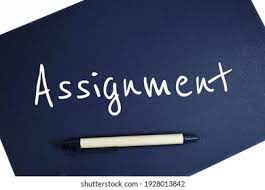When you start writing a financial assignment, there are various things that you should consider. The same goes with business as well and one of them is making financial reports/statements. Furthermore, these reports contain the financial activities of a certain period and guide in making beneficial decisions for the business. While facing any issues with this, you can take finance assignment writing help to guide you for the journey. But first, you will read about them in detail below.
What Are Financial Reports?
Financial reports or statements are documents containing everything about the financial condition of a company. In this information, there will be a collection of reports for a certain period, such as a month, year, or quarterly. It includes details such as the balance sheet, profit and loss, changes in equity, etc.
Understanding it in simpler terms means that every transaction in a company or business will record in a financial report. Whether it is buying, selling, exporting, production, or other financial transactions within a particular time frame.
Financial statements are typically prepared, using fair value or historical cost accounting principles as per the various experts.
Types of Financial Reports
A business needs to understand its financial statements properly. Because, individually or together, they provide data about the company to investors, which can impact the operations. These financial reports will give a comprehensive portrait of your money, i.e., where it is coming from, where it is going, and where it is currently.
Some types of reports together form a financial statement, you will read about them in detail below.
Balance Sheet
The balance sheet is a report that talks about the financial position of a company and its worth. It is one of the most significant financial statements used in every business. It will record the information as assets, liabilities, and equity.
1. Assets:
It is the value of things that the company owns or has. So, it typically means they could either sell or used by the company. Overall assets are of value to the business, such as equipment, inventory, and trademarks with all the investments.
2. Liabilities:
It is the value that the company has to pay back to others. Liabilities include all obligations, borrowed amounts, payrolls, various costs, and taxes. It will also include the responsibilities the customer needs to fulfil in the future, such as providing goods and services.
3. Equity:
It is also known as shareholder equity, capital, and net worth. It is the value, a company has after selling all its assets and paying off all its liabilities. This amount is the leftover money that belongs to the shareholders or owners of the company.
Income Statement
Income statements show how much a company has earned over time. It also includes all the expenses and costs associated with the amount. It will show you what’s earned or lost by the business in a certain period, i.e., all its profits and losses.
Furthermore, its made after a dedicated period of a month or a year at some palaces. It is an essential part of the management because this can help check the performance and adjust the strategy accordingly.
It will help them comprehend the points to gains and losses, whether the target acquired with the income or not, and if the costs are too large, etc.
There are usually four elements included in the income statement, namely:
- Revenue
- Expenses
- Profits
- Loss
Here, the profits earned are then categorised into five further parts, namely:
- Operating Profit
- Net Income
- Gross Profit
- Profit Before Tax
- Current Operating Profit
Understanding it together can sometimes be complex for you while working on a financial assignment. So, if you face any issues, feel free to seek the required help from the assignment writing service, available online.
Cash Flow Statement
The cash flow statement will provide a company’s view of all its cash transactions. It will calculate all the outward, inward, and leftover flows of cash in the company. It is significant because a business needs enough cash flow to maintain its operations, such as paying expenses and buying assets. Thus, a cash flow report will give you all the information related to the cash that the company generates. Usually, the cash flow statement is further divided into three review activities. You will read them below.
1. Operating Activities:
It is the first part of the cash flow statement and will analyse the net income or losses of the company’s cash. It will reconcile the income statement and the actual cash received from or used in operating activities. A company can record this cash flow through the sale of goods to customers and the purchases of tools and assets for a short period, along with other expenses.
2. Investing Activities:
It will include all kinds of cash transactions invested in something, such as buying long-term assets. Investing activities will analyse all the bonds, purchases of properties, stocks, securities, and other things counted as assets for the business. Here, all the purchases and sales will show up, which is either done because that has or will provide cash.
3. Financing Activities:
The third part of the cash flow statement will include every cash transaction from the financial activities. Here, the capital that can increase or decrease revenue will be closely related, such as dividend payments and credit debits. It will also include the cash collected by the sale of stocks or used the cash for paying a loan, etc.
Capital Changes Statement
It is a report usually prepared after the income statement and balance sheet. This statement will contain information about equity changes at any given time. Its related to changes in incoming or used capital. A Capital Changes Statement is a necessary statement for business owners, investors, stakeholders, and authority parties to find out about changes in the company’s future finances.
There are various essential parts of a capital change report, namely:
- Initial capital
- Additional capital
- Decrease in capital
- Final capital
Financial Statement Notes
It is the report that will provide extra information about the statements that already exist and mentioned above. For this, it has four main subsections, namely:
- General Information
- Used accounting principles
- Existing Assumptions
- Used Methods
So, these types of financial reports might play a crucial role in helping you meet the financial goals for your business.
Conclusion
You have already seen the details about them all but always remember that they are all interrelated and will work together. One report will not provide complete facts, but their combination will give dynamic figures to investors. Thus, it becomes a valuable tool for your company.
Hoping that this post guides you in understanding these reports and crafting a mind-blowing assignment. But if you are still in doubt, seek support from finance assignment writing help and that will make it easier for you to do it





